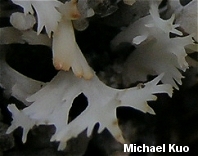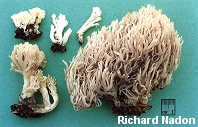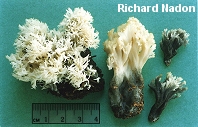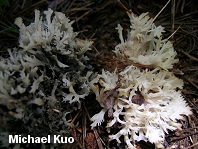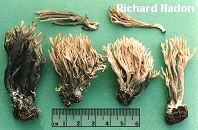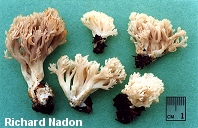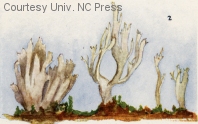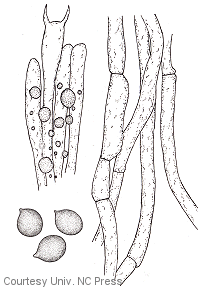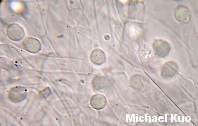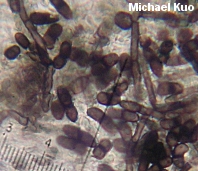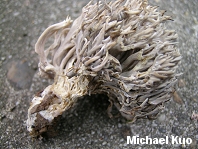| Major Groups > Clubs & Corals > Clavulina cristata |

|
Clavulina cristata [ Basidiomycetes > Cantharellales > Clavulinaceae > Clavulina . . . ] by Michael Kuo Also known as Clavulina coralloides, this distinctive coral mushroom can be recognized in the field by its white colors and "cristate" branch tips, which are flattened and feature several tiny points. However, several taxonomic and identification complications are involved with this fungus, so if your goal is simply to "put a name on" your white, cristate coral mushroom, write "Clavulina cristata" in your journal and stop reading now. The first complication involves Clavulina rugosa, which in its typical form looks very different (it has rugged surfaces, fewer branches, and blunt branch tips) but regularly appears to intergrade with Clavulina cristata and develop cristate branch tips. See the linked page for further discussion. The second complication involves another fungus, the pyrenomycete Helminthosphaeria clavariarum, which routinely parasitizes Clavulina cristata from the base upwards, rendering it gray to black. Under a hand lens, the tiny black dots that form the perithecia of the pyrenomycete can be seen--and under the microscope the Helminthosphaeria can't be missed. So far the second complication seems easy enough to decipher--but the third complication involves Clavulina cinerea, which has purplish gray to gray colors and bluntly pointed to cristate branch tips. So the question becomes: Is "Clavulina cinerea" a distinct entity, or does it merely represent forms of Clavulina cristata that have been attacked by Helminthosphaeria? A trip through field-guide illustrations and photos on the Internet suggests that while parasitized forms of Clavulina cristata may represent a few examples of "Clavulina cinerea," most of the illustrated specimens display grayish to purplish gray (not dark gray or black) colors on the branches and paler surfaces near the base of the mushroom, suggesting that the gray surfaces above do not represent the influence of the parasite, which attacks from the base upward. Also, the characteristic perithecia are missing in most photos (even with low resolution, perithecia can often be seen as tiny dots in photos; enlarge those of Richard Nadon, to the right, for examples). I have examined what I believe was Clavulina cinerea once (see the bottom photo)--but I hasten to add that I promptly lost the mushroom after drying it, and therefore can't assess its microscopic features to verify its identity. However, even if Clavulina cinerea does not (usually) represent parasitization of Clavulina cristata, it may still merely represent a gray and frequently less cristate form or "ecotype" of the latter. DNA studies have consistently placed Clavulina cristata alongside Hydnum repandum and chanterelles like Cantharellus cibarius, far from most other coral mushrooms--but the specific question of whether Clavulina cristata, Clavulina rugosa, and Clavulina cinerea represent separate species or forms of the same species has not been addressed, to my knowledge--though one study (Pine and collaborators, 1999) aligns the DNA of specimens identified as Clavulina cristata and Clavulina cinerea in the context of analyzing broader taxonomic groups within the field of chanterelle-like and Clavaria-like mushrooms. A pessimist might say that mycology has made little progress in this area since 1923, when Coker discussed the similarities among the three species for five long pages, citing an astounding number of specimens studied from across the globe, and concluding:
Clavulina coralloides may be the proper name for this species, since the name was coined by Linnaeus decades before the name cristata was used by Holmskjold. Description: Ecology: Presumed to be mycorrhizal with conifers and perhaps with hardwoods; growing alone, gregariously, or in clusters; summer and fall (over winter in warm climates); widely distributed in North America. Fruiting Body: 2-10 cm high; 3-10 cm wide; sparingly to (more commonly) repeatedly branched. Branches: 2-5 mm thick; smooth; white, sometimes becoming pinkish to pale pinkish brown with age; tips colored like the sides, flattened and "cristate" with several sharp points; grayish to brownish when dried for the herbarium; when parasitized becoming dark gray to black from the base upward, and eventually blackish overall. Base: When present .5-3 cm long; up to about 0.5 cm wide; white (gray to black when parasitized). Flesh: Whitish; fairly brittle. Odor and Taste: Not distinctive. Spore Print: White. Chemical Reactions: Irons salts negative on branches. Microscopic Features: Spores 7-11 x 6.5-10 µ; subglobose; smooth; with an apiculus. Basidia clavate; 40-60 x 6-8 µ; 2-sterigmate with long (5-7 µ), incurved sterigmata. Clamp connections present. REFERENCES: (Holmskjold, 1790) Schröter, 1888. (Linnaeus, 1753 [coralloides]; Fries, 1821 [coralloides]; Saccardo, 1888 [coralloides]; Coker, 1923; Corner, 1950; Smith, Smith & Weber, 1981; Weber & Smith, 1985; Arora, 1986; States, 1990; Phillips, 1991/2005; Lincoff, 1992; Metzler & Metzler, 1992; Barron, 1999; Roody, 2003; McNeil, 2006; Miller & Miller, 2006; Trudell & Ammirati, 2009.) Herb. Kuo 09120411, 09111017. This site contains no information about the edibility or toxicity of mushrooms. |
Illustrations from Coker (1923), courtesy of the University of North Carolina Press:
Clavulina cinerea?
© MushroomExpert.Com |
|
Cite this page as: Kuo, M. (2007, April). Clavulina cristata. Retrieved from the MushroomExpert.Com Web site: http://www.mushroomexpert.com/clavulina_cristata.html |
